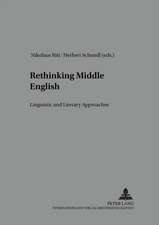Mind The Gap: Ellipsis and Stylistic Variation in Spoken and Written English: Textual Explorations
Autor Peter Wilsonen Limba Engleză Paperback – 16 mai 2000
| Toate formatele și edițiile | Preț | Express |
|---|---|---|
| Paperback (1) | 489.26 lei 43-57 zile | |
| Taylor & Francis – 16 mai 2000 | 489.26 lei 43-57 zile | |
| Hardback (1) | 1000.27 lei 43-57 zile | |
| Taylor & Francis – 19 ian 2017 | 1000.27 lei 43-57 zile |
Preț: 489.26 lei
Nou
Puncte Express: 734
Preț estimativ în valută:
93.62€ • 97.99$ • 77.92£
93.62€ • 97.99$ • 77.92£
Carte tipărită la comandă
Livrare economică 31 martie-14 aprilie
Preluare comenzi: 021 569.72.76
Specificații
ISBN-13: 9780582356795
ISBN-10: 0582356792
Pagini: 252
Dimensiuni: 156 x 234 x 15 mm
Greutate: 0.45 kg
Ediția:1
Editura: Taylor & Francis
Colecția Routledge
Seria Textual Explorations
Locul publicării:Oxford, United Kingdom
ISBN-10: 0582356792
Pagini: 252
Dimensiuni: 156 x 234 x 15 mm
Greutate: 0.45 kg
Ediția:1
Editura: Taylor & Francis
Colecția Routledge
Seria Textual Explorations
Locul publicării:Oxford, United Kingdom
Cuprins
Introduction
PART I: THE FORMS OF ELLIPSIS
1. What is ellipsis?
2. What isn't ellipsis
3. The linguistic context
4. The situational context
5. Telegraphic Ellipsis
6. Coordination Reduction
7. The rough guide to gaps
PART II: THE STYLISTIC EFFECTS OF ELLIPSIS
8. Style and stylistics
9. Speech styles and ellipsis
10. Sports Commentary
11. Dramatizing Dialogue
12. The conative turn
13. Narrative voices, narrative gaps
14. Ellipsis and compression in poetry
15. Conclusion
Bibliography
PART I: THE FORMS OF ELLIPSIS
1. What is ellipsis?
2. What isn't ellipsis
3. The linguistic context
4. The situational context
5. Telegraphic Ellipsis
6. Coordination Reduction
7. The rough guide to gaps
PART II: THE STYLISTIC EFFECTS OF ELLIPSIS
8. Style and stylistics
9. Speech styles and ellipsis
10. Sports Commentary
11. Dramatizing Dialogue
12. The conative turn
13. Narrative voices, narrative gaps
14. Ellipsis and compression in poetry
15. Conclusion
Bibliography
Descriere
We rarely speak or even write in the complete sentences that are often held to be the ideal form of linguistic communication. Language is in fact full of gaps as speakers and writers often communicate in situations which allow bits of language to be understood rather than expressed. This book examines this 'gappiness' of language, technically known as ellipsis, and provides an account of the different contexts, both linguistic and situational which affect its use.

















